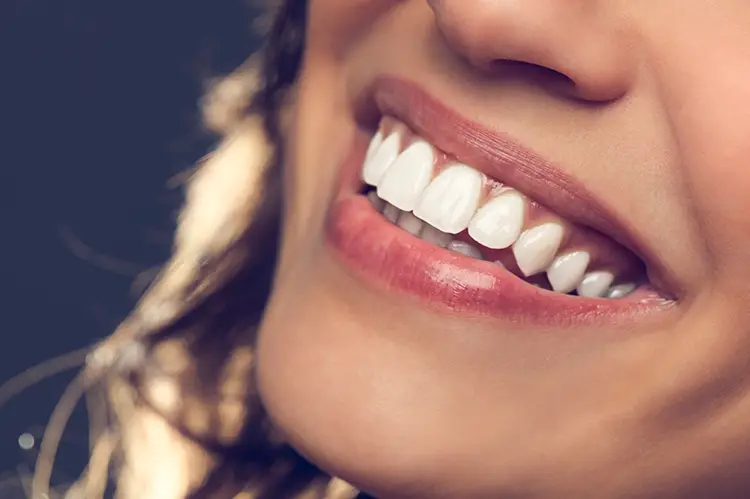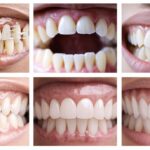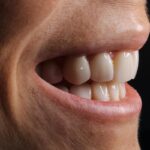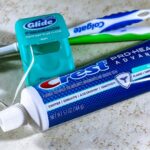Well-designed veneers are a quick way to cosmetically improve your smile, often using minimally invasive techniques. Veneers can correct numerous problems with the appearance of teeth, but you must make sure you know how this treatment will help you, and if it is appropriate and will achieve the results you desire. One thing to remember is that veneers cannot improve your dental health and are designed to provide purely cosmetic benefits. If you have problems affecting your profile, bite or facial proportions, you may need a different treatment choice. Your natural teeth are precious so it is vital to select the right cosmetic dentist who will provide you with the correct treatment, ideally preserving your natural teeth when placing your veneers.
What are Veneers?
Dental veneers are very thin shells, a little like a false fingernail and which will immediately improve the appearance of your teeth. They are custom-made to fit exactly over the front surface of a tooth and are bonded in place by your dentist. Treatment to place dental veneers will normally require two dental appointments. Veneers are made of composite resin or porcelain.
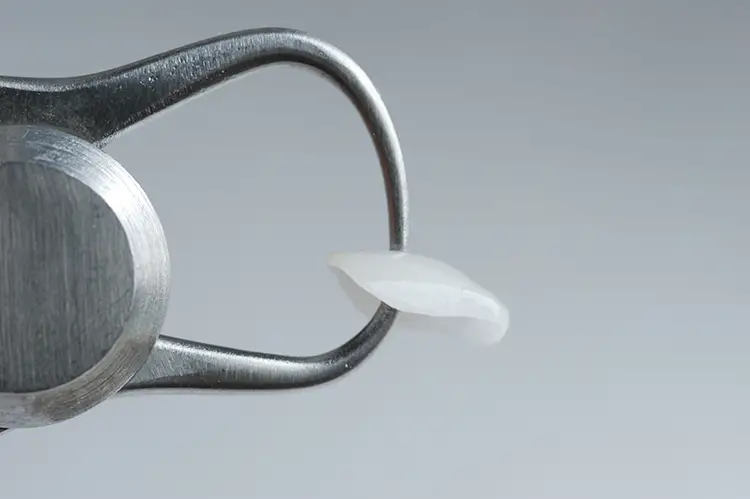
Porcelain veneers are also called ceramic veneers or dental porcelain laminates. Another name you might come across is Lumineers® which is a specific type of very thin porcelain used to make dental veneers. Lumineers® are often used during the placement of prepless or prep-free veneers. The term prep-free veneers or prepless veneers refers to the technique used to place them, where no healthy tooth structure is removed before placing the veneers. Other leading brand names for prep-less veneers include VivaneersTM and DURAthin® veneers.
A dental veneer is quite different from a crown that covers up the entire tooth and which requires the tooth to be significantly reshaped. In contrast, dental veneers require little or no preparation, are less intrusive and preserve most of or your entire natural tooth.
Types of Veneers
You can choose veneers made from porcelain or composite. Porcelain veneers are popular as this ceramic material is hard-wearing and stain resistant whereas composite isn’t quite as hard-wearing or resistant to staining. Once bonded onto teeth, ceramic veneers have a strength and resilience similar to natural tooth enamel.
Composite Resin
Composite resin veneers are made directly by your dentist so no dental impression is needed. The resin is applied to the tooth in small increments and is hardened, shaped and polished so treatment can frequently be completed in a single visit, depending on the number of veneers required.
Pros and Cons of Composite Veneers
This type of dental veneer is cost-effective and non-invasive and is ideal for correcting relatively minor problems with the appearance of your teeth. However, composite veneers will not last as long as porcelain veneers and this material can become stained, particularly if you smoke, drink tea or coffee or love highly colored foods. Generally, you will need to replace composite resin veneers every few years. Although composite resin can look great it cannot replicate the shades translucencies found in natural teeth as accurately as the more advanced porcelains.
Porcelain Veneers
Unlike composite veneers, porcelain veneers are indirect restorations meaning they are hand-crafted in a dental laboratory using a detailed impression of your teeth. There are many types of porcelain veneers and a good cosmetic dentist will choose the right solution for you. Porcelain veneers can last ten years or more and can be made in several different ways.
CEREC veneers are milled on-site from pre-shaded blocks of porcelain using advanced CAD/CAM technology to create your restorations while you wait. Once milled, the veneers are characterized and hand-finished and are ready for fitting.
Procera or Lava veneers are made from zirconia, a strong ceramic material made in a dental laboratory by milling the restorations before heating (sintering) them to extremely high temperatures. The zirconia veneers are then layered with porcelains creating durable and highly aesthetic restorations that are particularly suitable for more badly damaged and stained teeth.
No-prep veneers are created using specialized ultra-thin, extremely strong ceramics and do not usually require any tooth preparation.
Pressable veneers are laboratory-made using advanced e.max or Empress porcelains which then simply need to be shaped, characterized and glazed.
You will generally need at least two visits for porcelain veneers. However, CEREC veneers are made and fitted while you wait, using a digital impression of your teeth.
Pros and Cons of Porcelain Veneers
Porcelain veneers are stain-resistant and advanced porcelains can closely mimic the translucencies and shades found in natural teeth, providing the best aesthetic results. They will last longer than composite veneers but they are more expensive. If a porcelain veneer chips or cracks it cannot be repaired. The procedure to make and fit many types of ceramic veneers is often more invasive and more destructive than composite resin veneers.
Preparing Teeth for Veneers
Tooth preparation for conventional and prepless veneers is quite different and is explained below.
Placing Conventional Veneers
Quite often a dentist will prepare a tooth for a veneer by removing approximately 0.5mm of tooth enamel from the surface which is the typical thickness of a veneer. This preparation is carried out under local anesthetic and afterward the tooth might feel a little sensitive. After shaping the tooth, a detailed dental impression is taken and sent to the dental lab so your veneer can be fabricated to your dentist’s prescription. It normally takes two weeks for veneers to be made so your teeth will need to be protected during this time with temporary veneers. If CEREC veneers are being used, they can be made and fitted in a single visit, eliminating the need for temporary veneers. Conventional porcelain veneers are considered to be a minimally invasive procedure since most of your tooth structure is preserved while still achieving long-lasting smile rejuvenation.
Placing Prep-Free (No Drilling) Veneers
With prep-free or prepless veneers, no tooth preparation is necessary so your teeth are completely preserved. This may be due to the design of your veneers and some market brands such as Lumineers are exceptionally thin at around 0.2mm, making removal of tooth enamel unnecessary. Instead, your dentist will merely need to take an impression and you can return to have the veneers fitted at a later date.
Minimally Invasive versus Prep-Free Veneers
Prep-free veneers eliminate the need for uncomfortable injections and preserve healthy teeth fully intact. This is a huge advantage as removing any tooth material increases the risk of tooth sensitivity and opens the way for these teeth to become infected and decayed later in life. With prep-free veneers you will need to spend less time in the dental chair as all that is required is an impression of your teeth. All the design and making of your veneers will take place ‘behind the scenes.’ Prep-free veneers are also reversible, should you decide to get rid of your veneers in the future. Conventional veneers are irreversible. Once any tooth structure is removed from a tooth, that tooth will always need to be artificially covered up to prevent sensitivity, infection, and decay.
Who Needs Veneers?
Veneers can be used to mask discolored teeth that cannot be satisfactorily bleached with teeth whitening treatments, for example, if you have tetracycline stains or dental fluorosis that can cause white flecks or brown stains on teeth. Dental veneers can minimize or close gaps between teeth and bring slightly crooked teeth back into alignment. You might also consider veneers to hide any chips or cracks in teeth or to restore the shape and size of a tooth that is worn down or too small or which is a less than perfect shape. These are the practical considerations for getting veneers but there are also the emotional benefits of treatment.
Most patients are interested in using veneers to improve their smile and white, beautifully shaped teeth are associated with health and youthfulness. They may seek out treatment to improve their appearance or their career prospects. There is an increasing emphasis on looking as attractive and as youthful as possible and effective smile rejuvenation can help considerably.
Most people want natural-looking veneers that offer value for money and may opt for lower priced work, not realizing the difference between high-quality work and the veneers provided by dentists offering ‘cookie cutter’ solutions. A beautiful smile that compliments your facial features, personality, gender and skin tone can only be achieved when a talented dentist closely liaises with an experienced dental ceramist who is trained in using the very best and latest porcelains. Great porcelain veneers are a blend of science and artistry and getting the best possible treatment is worth the additional cost when you consider how long you may want to wear them. We see far too many patients that were treated by less talented cosmetic dentists and who have to spend more time and money replacing these veneers.
Spending time researching and choosing the right dentist for your veneers will help ensure you receive the smile you desire, without causing long-term damage to your teeth. Ultimately this will be better for your dental health and is much more cost-effective.
When Should You Not Get Veneers?
If you have a bad bite such as an overbite, an underbite, TMJ problems or bite related issues such as jaw pain, neck pain, sleep problems, speaking problems, premature aging and wrinkles, veneers will not help you. Sometimes patients of all ages want to improve their appearance but unfortunately, veneers can also cause unexpected problems. As an example, many patients want longer teeth and bite correction with VENLAY® Restorations would be the best choice. However, they choose the less expensive conventional veneers and end up with deeper overbites, broken veneers, sensitive teeth, and premature aging. You should not get veneers when you really need bite correction.
Veneers do not correct bites, do not improve chin sizes, facial profiles or the shape of your face while VENLAY® Restorations are specifically designed for bite correction and are the ultimate in anti-aging dentistry. VENLAY® Restorations offer superior results without grinding down healthy teeth to correct your bite. They can create wider and more beautiful smiles than conventional veneers, supporting your cheek muscles, creating a fuller and more youthful facial appearance and eliminating prematurely aging darker areas in your smile line.
How Long Do Veneers Last?
Veneers are not permanent but can last anywhere between 10-15 years, or longer depending on the choice of veneer. How long veneers last depends on the skill of the dentist and the technique used to bond the veneers to teeth. If the incorrect bonding technique is used then there is a greater chance the bond will fail, causing the veneers to fall off teeth. It is essential for the dentist to understand the bite and jaw position. Combining bite problems with conventional veneers commonly leads to chipped veneers and veneers falling off.
While veneers are not permanent, your treatment of them can help to prolong their life. Following a good oral hygiene routine that includes brushing at least twice a day and flossing once-a-day will help. You must see your dentist regularly for check-ups and hygiene appointments. Avoid using your teeth as tools as opening packets could weaken and chip your veneers as well as your natural teeth. If you clench or grind your teeth (bruxism), see your dentist for treatment as this will almost certainly damage your veneers. Wear a custom-made mouthguard when playing contact sports, or any sports where you could take a blow to the mouth.
Porcelain Veneers Gone Wrong
Porcelain laminates can fail for a number of different reasons. Often people will choose the cheapest quote for their veneers where a dentist may lack the skills and knowledge required to choose the right materials or design for the veneers, resulting in veneers that are opaque, bulky and unnatural. Where multiple veneers are placed it is sometimes necessary to use two different types of porcelains, especially if a tooth is heavily stained, but it takes experience to know this. The choice of dental laboratory can make a huge difference, as the ceramist needs to know how to create veneers that are age and gender appropriate (women’s teeth are quite a different shape from men’s) and which are characterized to create a natural appearance. To do this, the cosmetic dentist also needs to communicate with their chosen dental laboratory. A less experienced cosmetic dentist may choose to use a cheaper dental laboratory where quality control is not so important.
Traditional veneers require teeth to be ground down but when done incorrectly this can lead to a bad bite and problems with the jaw joints (TMJ problems). Problems with bruxism (teeth grinding and clenching) can cause veneers to fail. Minimal prep and no-prep veneers also require considerable skill to ensure the final veneers don’t look bulky and artificial and out of proportion. Extremely bulky veneers can affect gum health, causing gum infections and subsequent problems with gum recession.
Even if you have bad veneers then they can still be corrected with the right treatment from an experienced cosmetic dentist.
Correcting Bad Veneers
People with bad veneers often have unwanted tooth sensitivity caused by teeth having been extensively reshaped. The first thing your dentist will need to do is to remove these veneers without causing any damage to the teeth underneath.
As soon as the bad veneers are removed, tooth sensitivity can be reversed. Using magnification dentistry, bad veneers can easily be removed without filing down more tooth structure. If a dentist is highly skilled and has the best technology, the bonding layer can be removed without further damage to the patient’s remaining tooth structure. This stage is extremely important as it will preserve and protect the healthy tooth so new veneers can be safely and successfully placed.
How to Avoid Bad Porcelain Veneers
Everybody has a different perception as to why their veneers look bad. Some people hate the shape of their teeth and think they look too bulky. Other patients experience sensitivity that drives them a little crazy. All cosmetic dentists must have the ability to sell themselves to each patient so many patients get fooled. A great chair-side manner doesn’t mean your local dentist is the best person to makeover your smile. The best way to avoid bad porcelain veneers is to see photos of the dentist’s work and to view videos of satisfied patients.
Commonly Asked Questions about Veneers
How much do veneers cost?
If you have already visited some cosmetic dentists to enquire about veneers then you will have discovered huge differences in price. Why is it that some dentists can offer cheap veneers, and others charge what seems to be exorbitant fees? If you are in the market for cheap veneers, you are risking your health. The cost of dental veneers covers far more than the price of that tiny sliver of porcelain attached to your tooth. For a professional outcome, you need a dentist that understands every aspect of your mouth, your jaw, and your teeth. You are paying for the quality of the veneer, the way it’s crafted, the method of bonding, and most of all – the skill and experience of the dentist. If you are set on getting cheap veneers, you are risking your health and you are unlikely to get good cosmetic results.
Will my teeth be sensitive?
Far too many patients become upset after getting veneers because their teeth are so sensitive. Others have had so much sensitivity that their teeth need root canal therapy. When healthy teeth are extensively and often needlessly ground down this can cause unnecessary pain. This does not happen with everyone but it happens to far too many people and can be avoided with the correct veneer treatment.
Will veneers match my other teeth?
Initially, your veneers should accurately match your other teeth but over time your veneers and natural teeth will age differently. Usually, teeth with veneers will not be as yellow as your other teeth. This is why it is generally better to have at least 8 veneers done at the same time so they will age the same way.
Do porcelain veneers stain?
Porcelain veneers are very resistant to staining and any surface stains can easily be removed. Stains cannot penetrate porcelain as they can with natural teeth.
Can I get cavities after veneers?
Yes, you can get cavities after veneers but if you floss, brush and water pik every night and every morning the likelihood of getting cavities after veneers is low.
How are veneers attached?
Veneers are attached using a bonding process to integrate the porcelain veneer to the tooth structure. If the dentist ground down your teeth, the bond will be weaker than with prepless veneers. There are many different bonding methods so be careful when going to a low-priced dentist because this generally means a cheaper method is used.
Can veneers be removed?
Veneers can easily be removed and replaced. Prepless veneers are easiest to replace because you don’t need shots. The more invasive type of veneer where some tooth structure is removed requires shots and temporary veneers but again, replacing veneers is not a difficult process for our office.
How do I maintain porcelain veneers?
You maintain porcelain veneers the same way you maintain your natural teeth. Floss, brush and water floss every night and every morning and do not suck on lemons, chew on ice, open bottles with your teeth or use your teeth or veneers as cutting tools.
How long will it take to get porcelain veneers?
Porcelain veneer treatment may take a few days to two weeks depending on your budget. Dental veneers are a procedure that has helped many patients experience all the benefits of a more attractive smile. However, today’s patients are much more sophisticated than in the past. They demand excellent aesthetics and want a natural looking result, not just a better result.
By choosing the right cosmetic dentist for your veneers, you can be confident of receiving beautiful, natural looking teeth while protecting your dental health.

